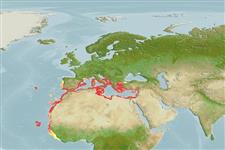>
Pleuronectiformes (Flatfishes) >
Bothidae (Lefteye flounders)
Etymology: Arnoglossus: Greek, aros, -oy = lamb + Greek, glossa = tongue (Ref. 45335).
Environment: milieu / climate zone / depth range / distribution range
Écologie
marin démersal; profondeur 15 - 300 m (Ref. 5979). Subtropical; 43°N - 6°N, 26°W - 42°E
Eastern Atlantic: Ireland (Ref. 4704) to Sierra Leone and Cape Verde. Also known from the western Mediterranean and Black Sea.
Length at first maturity / Taille / Poids / Âge
Maturity: Lm 8.8, range 12 - ? cm
Max length : 18.0 cm SL mâle / non sexé; (Ref. 4704); common length : 12.0 cm TL mâle / non sexé; (Ref. 3397); âge max. reporté: 10 années (Ref. 32766)
Épines dorsales (Total): 0; Rayons mous dorsaux (Total): 81-91; Rayons mous anaux: 61 - 69. Second ray of dorsal fin very long, with a conspicuous dark, fringed broad membrane. First 3 or 4 dorsal fin rays generally blackish in adults but only the elongate second ray is dark in immature fishes.
Found on the upper 100 m of the continental shelf. Feeds on small fishes and invertebrates (Ref. 4704). Minimum depth reported taken from Ref. 52678 but has been caught in depths inferior to 10m (Ref. 57407).
Aldebert, Y., M. Desoutter and J.-C. Quéro, 1990. Bothidae. p. 1027-1036. In J.C. Quero, J.C. Hureau, C. Karrer, A. Post and L. Saldanha (eds.) Check-list of the fishes of the eastern tropical Atlantic (CLOFETA). JNICT, Lisbon; SEI, Paris; and UNESCO, Paris. Vol. 2. (Ref. 5979)
Statut dans la liste rouge de l'IUCN (Ref. 130435)
Menace pour l'homme
Harmless
Utilisations par l'homme
Pêcheries: intérêt commercial mineur
Plus d'informations
RéférencesAquacultureProfil d'aquacultureSouchesGénétiqueElectrophoresesHéritabilitéPathologiesTraitementNutrientsMass conversion
Outils
Articles particuliers
Télécharger en XML
Sources Internet
Estimates based on models
Preferred temperature (Ref.
123201): 13.7 - 18.6, mean 15.4 °C (based on 138 cells).
Phylogenetic diversity index (Ref.
82804): PD
50 = 0.5000 [Uniqueness, from 0.5 = low to 2.0 = high].
Bayesian length-weight: a=0.00724 (0.00566 - 0.00927), b=3.07 (3.01 - 3.13), in cm total length, based on LWR estimates for this species (Ref.
93245).
Niveau trophique (Ref.
69278): 3.3 ±0.5 se; based on diet studies.
Résilience (Ref.
120179): Milieu, temps minimum de doublement de population : 1,4 à 4,4 années (K=0.51-0.58; tm=2; tmax=10).
Fishing Vulnerability (Ref.
59153): Low vulnerability (24 of 100).
Nutrients (Ref.
124155): Calcium = 140 [67, 304] mg/100g; Iron = 1.25 [0.57, 2.22] mg/100g; Protein = 18.3 [16.9, 19.8] %; Omega3 = 0.327 [0.141, 0.664] g/100g; Selenium = 29.1 [14.9, 58.3] μg/100g; VitaminA = 17.5 [5.7, 51.3] μg/100g; Zinc = 0.931 [0.634, 1.335] mg/100g (wet weight);
